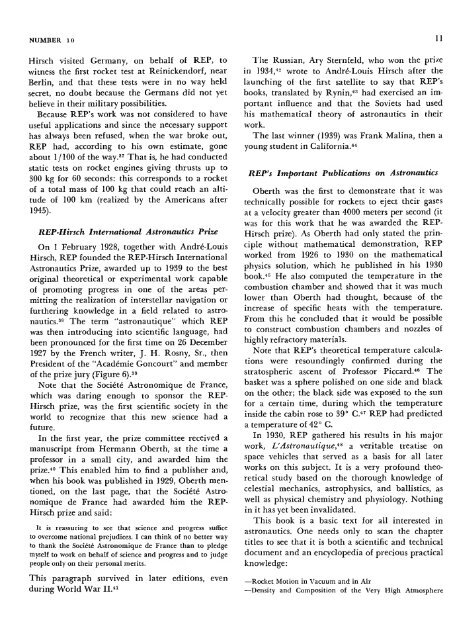FIRST STEPS TOWARD SPACE - Smithsonian Institution Libraries
FIRST STEPS TOWARD SPACE - Smithsonian Institution Libraries
FIRST STEPS TOWARD SPACE - Smithsonian Institution Libraries
Create successful ePaper yourself
Turn your PDF publications into a flip-book with our unique Google optimized e-Paper software.
NUMBER 10<br />
Hirsch visited Germany, on behalf of REP, to<br />
witness the first rocket test at Reinickendorf, near<br />
Berlin, and that these tests were in no way held<br />
secret, no doubt because the Germans did not yet<br />
believe in their military possibilities.<br />
Because REP's work was not considered to have<br />
useful applications and since the necessary support<br />
has always been refused, when the war broke out,<br />
REP had, according to his own estimate, gone<br />
about 1/100 of the way. 37 That is, he had conducted<br />
static tests on rocket engines giving thrusts up to<br />
300 kg for 60 seconds: this corresponds to a rocket<br />
of a total mass of 100 kg that could reach an altitude<br />
of 100 km (realized by the Americans after<br />
1945).<br />
REP-Hirsch International Astronautics Prize<br />
On 1 February 1928, together with Andre-Louis<br />
Hirsch, REP founded the REP-Hirsch International<br />
Astronautics Prize, awarded up to 1939 to the best<br />
original theoretical or experimental work capable<br />
of promoting progress in one of the areas permitting<br />
the realization of interstellar navigation or<br />
furthering knowledge in a field related to astronautics.<br />
38 The term "astronautique" which REP<br />
was then introducing into scientific language, had<br />
been pronounced for the first time on 26 December<br />
1927 by the French writer, J. H. Rosny, Sr., then<br />
President of the "Academie Goncourt" and member<br />
of the prize jury (Figure 6). 39<br />
Note that the Society Astronomique de France,<br />
which was daring enough to sponsor the REP-<br />
Hirsch prize, was the first scientific society in the<br />
world to recognize that this new science had a<br />
future.<br />
In the first year, the prize committee received a<br />
manuscript from Hermann Oberth, at the time a<br />
professor in a small city, and awarded him the<br />
prize. 40 This enabled him to find a publisher and,<br />
when his book was published in 1929, Oberth mentioned,<br />
on the last page, that the Soci£t6 Astronomique<br />
de France had awarded him the REP-<br />
Hirsch prize and said:<br />
It is reassuring to see that science and progress suffice<br />
to overcome national prejudices. I can think of no better way<br />
to thank the Societe Astronomique de France than to pledge<br />
myself to work on behalf of science and progress and to judge<br />
people only on their personal merits.<br />
This paragraph survived in later editions, even<br />
during World War II. 41<br />
The Russian, Ary Sternfeld, who won the prize<br />
in 1934, 42 wrote to Andre-Louis Hirsch after the<br />
launching of the first satellite to say that REP's<br />
books, translated by Rynin, 41 had exercised an important<br />
influence and that the Soviets had used<br />
his mathematical theory of astronautics in their<br />
work.<br />
The last winner (1939) was Frank Malina, then a<br />
young student in California. 44<br />
REP's Important Publications on Astronautics<br />
Oberth was the first to demonstrate that it was<br />
technically possible for rockets to eject their gases<br />
at a velocity greater than 4000 meters per second (it<br />
was for this work that he was awarded the REP-<br />
Hirsch prize). As Oberth had only stated the principle<br />
without mathematical demonstration, REP<br />
worked from 1926 to 1930 on the mathematical<br />
physics solution, which he published in his 1930<br />
book. 45 He also computed the temperature in the<br />
combustion chamber and showed that it was much<br />
lower than Oberth had thought, because of the<br />
increase of specific heats with the temperature.<br />
From this he concluded that it would be possible<br />
to construct combustion chambers and nozzles of<br />
highly refractory materials.<br />
Note that REP's theoretical temperature calculations<br />
were resoundingly confirmed during the<br />
stratospheric ascent of Professor Piccard. 46 The<br />
basket was a sphere polished on one side and black<br />
on the other; the black side was exposed to the sun<br />
for a certain time, during which the temperature<br />
inside the cabin rose to 39° C. 47 REP had predicted<br />
a temperature of 42° C.<br />
In 1930, REP gathered his results in his major<br />
work, L'Astronautique, 48 a veritable treatise on<br />
space vehicles that served as a basis for all later<br />
works on this subject. It is a very profound theoretical<br />
study based on the thorough knowledge of<br />
celestial mechanics, astrophysics, and ballistics, as<br />
well as physical chemistry and physiology. Nothing<br />
in it has yet been invalidated.<br />
This book is a basic text for all interested in<br />
astronautics. One needs only to scan the chapter<br />
titles to see that it is both a scientific and technical<br />
document and an encyclopedia of precious practical<br />
knowledge:<br />
—Rocket Motion in Vacuum and in Air<br />
—Density and Composition of the Very High Atmosphere<br />
11

















